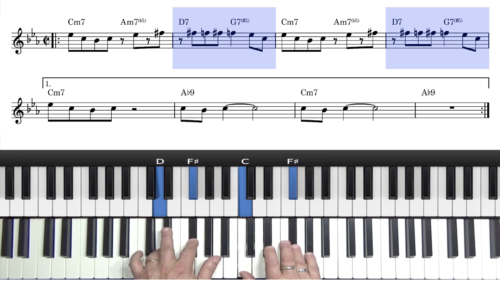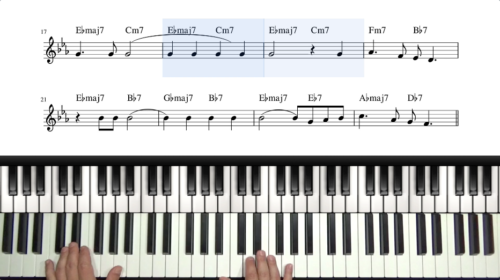Triste Tutorial
In this tutorial we explore the harmony of tune ‘Triste’ by Antonio Carlos Jobim.
‘Triste’ is the Portuguese word for ‘sad’ however in the Brazilian culture ‘triste’ can have a cheerful connotation which is reflected by the upbeat and colourful vibe of this tune.
Triste Vamp Chord Voicings
Jovino explains the importance of the first 2 chords in the form (Fmaj7 and Dbmaj7/F) and how these chords can be used to create a vamp and to set up the groove for the performance.
Triste Comping Voicings
It’s important for the pianist to learn voicings for accompaniment to understand the possibilities for the rhythmic accompaniment of the tune. Jovino demonstrates how we can play the tune with a left hand bass line and right hand comping chords.
Triste 2/4 Time Signature
A lot of jazz music is written in 4/4. However, Brazilian jazz standards are often written in 2/4. Jovino discusses the importance of the 2/4 time signature and how this helps to develop an authentic Brazilian groove.
Practice Tips
-
First learn the accompaniment to the tune using a left hand bass line and right hand comping voicings. Then add the melody.
-
Study the subtle but effective rehamronisations that Jovino demonstrates.
-
Learn to play the original chord chord changes before experimenting with reharmonisations.
-
Develop your improvisation skills over the first 2 chords in the form as Jovino demonstrates in chapter 5 of the lesson.







Ola Jovino,
All comes so naturally to you that it rolls off your fingers, but as I try to follow your chord progressions and arpeggios, I quickly stop the video action to jot them down, particularly if they are ones I am learning. The video program, however, is hard to control.
It takes hours to jot them down with my crude video maneuvering.
It would be so helpful if
1. there would be a way to ‘stop capture’ the chords and arpeggios that you play during your lessons
2. you might stop the action during the tutorials and momentarily pause the arpeggios and stopped chords as you play them, particularly the more sophisticated sounds that are a combination of minors and 6s & 7s etc.
Can you please “stop” (in a good way) the action of your tutorials?
Maybe there is an easier way? Someone might be able to suggest one. I am determined to have in my head and hands all the 7th chords (M,m,D,dim)in all keys, but mastering them does not just happen overnight.
Thanks for such wonderful arrangements, yours and Tom Jobim’s, com certezal!
Obrigado!
N